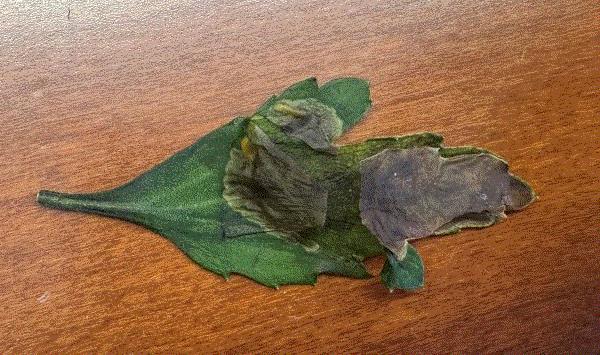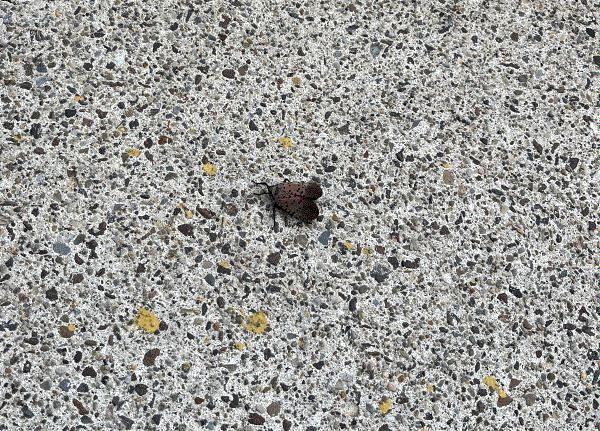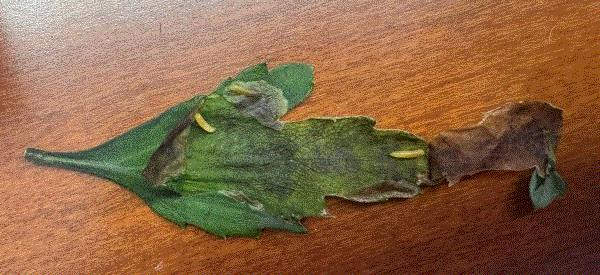What the ... ?
I talked about pests and diseases of mums in the last issue. Within a few hours of sending out the newsletter, I received a couple of pictures from Duane, who said that his grower brought in the pictured mum leaf that day. Some yellow critters can be seen under the leaf in the picture.
What are we looking at here?

SLF Found in South Carolina
Folks were telling me about their spotted lanternfly (SLF) signthings after I said that I'd seen them in downtown Columbus, Ohio, during Cultivate in the last issue. Little did I know that what I feared finally (as it almost always does) happened in my home state as I had my nose in other people's businesses—SLF has been found in South Carolina.
Clemson University’s Department of Plant Industry announced in mid-July that populations had been detected in the cities of Greenville and Seneca (Greenville and Oconee County, respectively) in the upstate region of South Carolina. Go HERE for the announcement.

This dying spotted lanternfly probably was trying to tell me that I have it coming when I was taking its picture in Columbus, Ohio.
David Coyle of Clemson University’s Department of Forestry & Environmental Conservation stated that the spread of SLF into South Carolina is inevitable. I agree with that. In 2019, David, Brett Blaauw and I co-authored an article on SLF management in nurseries, orchards, vineyards and natural areas in anticipation of SLF’s spread into Georgia and South Carolina. (Go HERE for the article.) With the detections in both states this year, it adds urgency to updating the article.
The detection makes South Carolina the 18th state where established populations have been reported. Along with the populations in Georgia (Fulton County), North Carolina (Forsyth, Guilford and Rockingham County), and Tennessee (Davidson, Sullivan and Wilson County), the detection in South Carolina marks another southern expansion of SLF distribution. The southern-most infestation range is near Atlanta, Georgia.
No quarantine or other regulatory actions have been declared for South Carolina at this time. Clemson University will coordinate with South Carolina Department of Agriculture, South Carolina Forestry Commission and USDA-APHIS on surveys, management and education around SLF. Folks are encouraged to report sightings of SLF in South Carolina by going HERE.

BioSafe Systems Launches BioPhyter
BioSafe Systems has launched a new product in the horticulture and agriculture markets. Called BioPhyter, this is a new Beauveria bassiana product. Different from other B. bassiana products, BipPhyter is derived from plants. It’s a systemic endophyte that can colonize plants systematically, from roots throughout the canopy. It aims to enhance the physiological functions of plants by strengthening the vascular system. The treated and stronger plants should be able to better tolerate biotic and abiotic stressors.

BioPhyter also contributes to faster germination and pest management via its anti-herbivory properties and compatibility with biological control. Based on the description and deemphasizing of bioinsecticide property, BioPhyter seems to me more a biostimulant than bioinsecticide. The product can be applied via irrigation, dip, drench and foliar application.
I haven’t tested BioPhyter so I can’t say much about its efficacy based on first-hand experience. I also couldn’t find more information about this product (label, technical paper, etc.). I’ll dig deeper into the product and report back in the next few weeks. In the meantime, go HERE for the news release.

IR-4 Grower Survey
The IR-4 Environmental Horticulture (EH) Workshop will be held in early October in Kansas City, Missouri. I don’t think I’ve missed this biennial meeting for the past 20 years. For me, this meeting is important because this is where IR-4 sets its research priorities. What I think is worth studying wouldn’t be given priority in funding if I didn’t show up to defend my choices. (In most years, I can huff and puff and still not get what I want. That’s evident when scale insects and mealybugs aren’t the priorities every year.)
What the IR-4 EH Program uses to guide discussions at the workshop and its final research priorities are the actual needs of growers and extension staff. The IR-4 EH Program finds out what’s important by conducting a Grower and Extension Survey every other year.
There’s a survey out ahead of this year’s workshop. I’d like to ask you to take five to 10 minutes to complete the survey by going HERE. You don’t have to give your name and address, but it’ll be important to tell IR-4 your state. Why? Because the states or regions that send in more responses may skew the survey results in favor of pest management issues that are important for those states or regions. (Also, researchers that attend the meeting also take pride in having more responses from their states.)
Complete the survey today to make your voice and concerns heard! The deadline for completing the survey is August 29.
If you know the specific product you need to address your disease, pest or weed problem, you can fill out and submit a Project Request Form. For example, if you know Product A works great in controlling Botrytis on strawberry, but it isn’t registered for use on bedding plants, then fill out a Project Request Form and ask IR-4 to take a look at this product. After all, a major mission of the IR-4 EH Program is to bring new products to the ornamental market. A pesticide manufacturer can then register Product A for use on bedding plants using data generated by the IR-4 EH Program. The deadline for submitting a project request is also August 29.

BioControl Conference and AFE Webinar
Rosa Raudales and her colleagues at the University of Connecticut have organized a Biological Control Conference for Ornamental Growers to be held at the Connecticut Agricultural Experiment Station in New Haven, Connecticut, on September 18. The cost of attending is $70 per person. Go HERE to find more information on the workshop.
The in-person workshop will start at 8:00 a.m. Eastern. Topics to be covered include biostimulants (by Michelle Jones of The Ohio State University), pest and beneficial scouting (by Suzanne Wainwright-Evans), biocontrol for houseplants and succulents (by Chris Schlegel of D.S. Cole Growers), biocontrol quality control and assessment (also by Suzanne), biological disease and pest management (by Michael Brownbridge of BioWorks), and discussions on application and new biocontrol agents (from Doug Barrow of BioBee, Phil Gerry of Koppert and Liz Keyser of IPM Labs). Pesticide recertification credits will be offered.
I also want to let y’all know that AFE Grow Pro Webinar Series will present a session on the IPM of Thrips parvispinus on August 19, 1:00 p.m. Eastern. This session is sponsored by BioWorks. The speaker is Rose Buitenhuis of Vineland Research & Innovation Centre. Rose will talk about her recent research on the management of this invasive thrips species, including using cutting dips as a management approach. Attendees will also learn about the biology and behaviors of the thrips species and how to control them using an IPM approach. Go HERE to sign up for the free webinar.

Answer to "What the ... ?"
Duane’s pictures brought back memories. The first picture shows some yellow critters hiding in leaf blisters. Duane opened the blisters and exposed the yellow critters (three on the same leaf!), shown in the second picture below. Those yellow critters are leafminer maggots. Actually, I already gave away the answer in the subject line of today's newsletter.
I haven’t seen leafminers on mums for a while. I’ll venture to bet that some of our younger growers have only heard of leafminers on mums from the textbooks or scary stories growers tell each other around campfires. (Or benches or dump piles ...? I imagine that’s how growers pass the time when I’m not watching.) But if you’ve been around long enough (try not to date yourself), you probably remember that leafminers were the No. 1 pest of mums from the 1980s to 2000s. It was a major pest of gerbera daisies when I was a graduate student under the late Dr. Ron Oetting at the University of Georgia and it still is! They never go away, just change what they work on (kind of like me).
On mums, most folks are familiar with meandering or serpentine mines. These serpentine mines are caused by the serpentine leafminers, which is commonly the American serpentine leafminer, and occasionally the vegetable leafminer or the pea leafminer. The serpentine leafminer species are in the genus Liriomyza. On rare occasions, blotch mines (like those in Duane’s pictures) appear. The blotch mine threw Duane for a loop since it isn’t something we often see on mums.

Two leafminer maggots are exposed after the mines are opened. One maggot is still in the mine.
Are we looking at a Liriomyza species or something else? It’s possible that the American serpentine leafminers feed in a small area and cause the mines to come together into a blotch. It could also be that the blotch mine is caused by the chrysanthemum leafminer, which is in a different genus (Nemorimyza) from the serpentine leafminers. The chrysanthemum leafminer isn’t a chrysanthemum specialist despite what its common name may suggest. I’d seen chrysanthemum leafminers on many plant species (fireweed and black-eyed Susan, to name a couple) and outdoors (never seen them indoors).
It’s hard to determine which species is the real culprit based on the appearance of the mines and the maggots. The best way to figure out which species is to catch the adults and see what they look like. The serpentine leafminers and the chrysanthemum leafminer are small flies—a little bigger than fruit flies. The serpentine leafminers are a mix of black and yellow on the body (quite adorable, I think, if not for their potential to devastate a crop). The chrysanthemum leafminers are mainly black or grey with very little contrasting colors.
If I was a betting man, I’d put my money on the culprit being the serpentine leafminers. As shown in the picture, three maggots can do quite a bit of damage to a leaf. The mines from three maggots can easily cross each other and come together into a blotch mine. Or they just don’t really want to see each other, so the maggots restrict their feeding to areas immediately around them and cause blotch mines.

Leafminer Control
Now that we know it’s leafminer, what in the world are we going to do about that?
One of the major reasons for the severity of serpentine leafminer infestations in previous decades is the development of insecticide resistance, particularly resistance against chlorpyrifos and pyrethroids. Management didn’t get any easier after throwing the kitchen sink at the problem. The introduction of new insecticides (such as neonicotinoids, abamectin and spinosad) and effective biological control agents (the parasitoids Diglyphus isaea and Dacnusa sibirica) finally turned the corner. But you know how it goes—when something works great, folks use it to death. Resistance against abamectin, cyromazine and spinosad were detected in the early 2000s.
These days, leafminers have been relegated from a major pest to an occasional pest on mums because of a wide array of effective insecticides, rotation of these insecticides, the use of biological control, and more diligent stock plant maintenance and cutting production practices. But watch out! Insecticide resistance will occur again if we get lazy and rely entirely on insecticides.
Exclusion, sanitation and timely management are keys to keeping stock plants clean. Sourcing cuttings from reputable suppliers is an important first step for those finishing a mum crop. Sanitation, particularly the elimination of weeds and leftover crops, is very important to reducing alternative hosts or refuges for leafminers in greenhouses. Try not to put a new crop next to one that's currently or was previously infested.
Yellow sticky cards should be used to monitor adults. Also, examine mum leaves regularly to look for stippling (scars left after egg laying or feeding) and mines. There isn’t an established threshold, so I recommend starting biological control or insecticide applications as soon as leafminers or their damage are detected.
I’ve seen very good efficacy with drenches of neonicotinoids (Safari and Meridian, in particular) and cyantraniliprole (Mainspring), so I would recommend drenching these insecticides as a preventive program or early in infestation. Other insecticides should be sprayed.
Although there are reports of resistance against abamectin (Avid and others), cyromazine (Citation) and spinosad (Conserve) in the past, these translaminar products are still effective in my experience (perhaps because the level of resistance has gone down or I didn’t have resistant populations). Other insecticides that I’d found effective are acetamiprid (Tristar) and novaluron (Pedestal) and, of course, sprays of dinotefuran, thiamethoxam and cyantraniliprole. You can also use the oldies, such as acephate and pyrethroids, but understand that these products are only effective against adults and therefore will not deal with larvae and solve the problem at the cause. Lastly, repeated applications are often needed to keep the damage down.
Go HERE for an earlier issue of this newsletter where I talked about managing leafminers in general.
Paulo Santos (at the time of publication a production manager at GroLink) mentioned in a GrowerTalks article that trap plants can be used to manage leafminers in mums. You can place yellow marigolds in the greenhouse at 6 pots per 2,000 sq. ft. Adult leafminers (as well as thrips) prefer marigolds over mums. You can swap out heavily infested marigolds from fresh ones regularly, and by doing so, you’re basically taking out larvae from the overall population. I’d never heard of this method before, but it makes sense and probably worth a try!
Paulo also has other management tips, particularly relevant to cutting production, in the article. Go HERE to read it.


See y'all later!

JC Chong
Technical Development Manager at SePRO
Adjunct Professor at Clemson University
This e-mail received by 27,847 subscribers like you!
If you're interested in advertising on PestTalks contact Kim Brown ASAP!